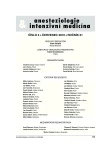Brachial plexus fascias
Authors:
Nalos Daniel 1; Bejšovec David 1; Nováková Martina 3; Derner Milouš 2
Authors‘ workplace:
ARO Masarykovy nemocnice, Ústí nad Labem, Krajská zdravotní a. s., 2Radiodiagnostické oddělení Masarykova nemocnice, Ústí nad Labem, Krajská zdravotní a. s., 3Fakulta biomedicínksého inženýrství, ČVUT, Praha
1
Published in:
Anest. intenziv. Med., 21, 2010, č. 4, s. 185-190
Category:
Original Article
Overview
Objective:
To elucidate the functional anatomy of the brachial plexus, its relationship to the surrounding structures and their influence on the spread of local anaesthetics. Furthermore, to compare the clinical experience and the role of functional anatomy on the extent and quality of various techniques of brachial plexus blockade.
Design:
Prospective, human study.
Setting:
Departments of Anaesthesia and Radiology (CT suite).
Materials and methods:
Diluted (1 : 5) contrast agent (Iomeron 400, Bracco Imaging) was injected via the interscalene, infraclavicular and axillary routes to simulate brachial plexus block. The first author of this publication stood as the model. The total amount of the injected solution was 20, 35 and 35 ml, respectively. A CT scan of the brachial plexus was performed 20 minutes post-injection. All three techniques of the simulated blockade were performed in succession on both the left and right sides. The figures presented here come from the right-sided injection and are representative of both sides. Horizontal, vertical and oblique axial slices parallel to the brachial plexus and slices perpendicular to the brachial plexus were taken. 3D reconstructions of the contrast location along the brachial plexus were performed.
Results:
The brachial plexus fascias and compliance of the surrounding structures are crucial for the extent of local anaesthetic spread along the plexus. Application of the local anaesthetic solution in the appropriate fascia space is more important than the distance of the needle from the nerve roots. The determining structure for the local anaesthetic spread in the supraclavicular area is the independent fascia covering the scalene muscle group. Large vessel fascias join the fascias of the brachial plexus in the infraclavicular area while the fluid distribution is greatly determined by the subclavian muscle. The fascias divide towards the individual nerves of the brachial plexus in the coracoid process area. We confirm that the ulnar and median nerves are covered by the same fascia in the axilla. The authors report no negative consequences of the experiment on the model.
Conclusion:
A similar human investigation of the local anaesthetic spread along the brachial plexus has not been described outside the axillary area. The CT scans demonstrate novel information about local anaesthetic spread inside the brachial plexus fascia. Application of the local anaesthetic solution in the appropriate fascia space is more important than the distance of the needle from the nerve roots.
Keywords:
regional anaesthesia – brachial plexus – plexus fascia – scalene fascia
Sources
1. Winine, A. P. Plexus Anesthesia Volume I. Third printing, Mediglobe SA, 1993, p. 121–181.
2. Kauter, A. R., Smith, H. J., Stubhaug, A., Dodgson, M. S., Klaastad, O. Use of magnetic Resonance Imaging to Define the Anatomical Location Closest to All Three Cords of Brachial Plexus. Anest. analg., 2006, 6, p. 1574–1576.
3. Nalos, D. Infraclavikulární blokáda k brachiálnímu plexu. Anest. neodklad. Péče, 1993, 4, p. 98–99.
4. Nalos, D., Mach, D. Periferní nervové blokády. Grada Publishing, 2010, p. 96–113.
5. Pandit, J. J., Dutta, D., Morfia, J. F. Spread of injectate with superficial cervical plexu block in humans: an anatomical study. Br. J. Aneasth., 2003, 91, p. 733–735.
6. Platzer, W. Atlas topografické anatomie. Grada Publishing, 1996, p. 53–80.
7. Gadsden, J. C., Lindenmuth, D. M., Hadic, A., Daquan, X., Lakshmanasamy Somasundarum, Flisinsky, K. A. Lumbar Plexus Block High-pressure Injection Leads to Contralateral and Epidural Spread. Aneastheosiol., 2008, p. 683–688.
Labels
Anaesthesiology, Resuscitation and Inten Intensive Care MedicineArticle was published in
Anaesthesiology and Intensive Care Medicine

2010 Issue 4
Most read in this issue
- Postoperative sore throat
- Prometheus therapy in patients with acute liver failure – the effect on the inflammation and regeneration markers
- Prometheus – a new therapeutic option in liver failure in children
- Brachial plexus fascias
